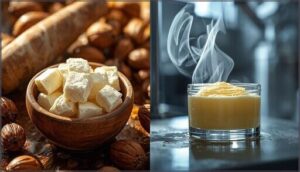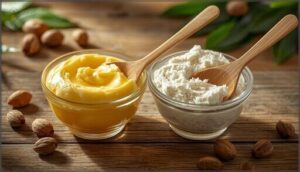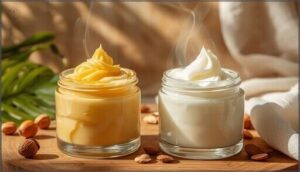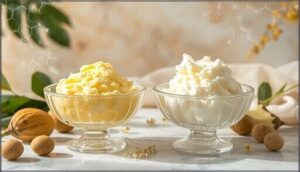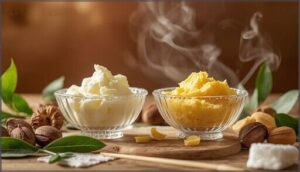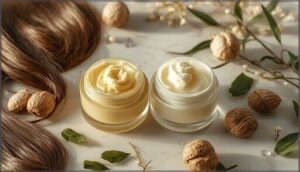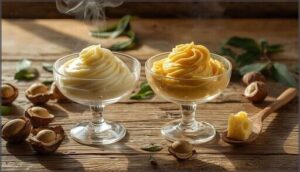This site is supported by our readers. We may earn a commission, at no cost to you, if you purchase through links.
You’ve probably stood in the skincare aisle wondering why shea butter comes in two different colors—and whether it actually matters for your skin. The confusion makes sense: yellow or white shea butter can look dramatically different, yet both claim similar benefits.
What most people don’t realize is that the color difference isn’t just cosmetic—it reveals how the butter was processed, which directly impacts the nutrients your skin receives. Yellow shea butter generally retains higher levels of vitamin E (around 3788 ppm) because it’s minimally processed, while white versions often undergo refining that strips away up to 95% of beneficial compounds.
Your skin type, texture preferences, and specific skincare goals all play a role in determining which option delivers better results for you.
Table Of Contents
Key Takeaways
- Yellow shea butter retains significantly higher nutrient levels (around 3788 ppm vitamin E) due to minimal processing, while white shea butter loses up to 95% of beneficial compounds through refining that removes color and scent.
- The processing method directly impacts texture and application—yellow offers soft, elastic consistency with nutty aroma ideal for intensive hydration, whereas white provides firmer, nearly scentless texture that absorbs quickly for daily use.
- Skin type determines your best choice: sensitive and oily skin generally responds better to white shea butter’s lighter formulation, while dry skin benefits from yellow’s richer moisture barrier and 83.7% hydration boost.
- Despite common concerns, shea butter shows zero documented allergic reactions worldwide and remains safe even for nut-allergic individuals, with both varieties tested at 70% concentrations without adverse effects.
Yellow Vs. White Shea Butter: Key Differences
You might think shea butter is just shea butter, but the yellow and white versions aren’t identical twins. The differences between them come down to how they’re processed, what they look like, and how they feel and smell on your skin.
Let’s break down what sets these two apart so you can figure out which one works best for you.
Origin and Processing Methods
Understanding the extraction process behind yellow and white shea butter reveals why they differ so dramatically. Both originate from the African shea tree, but their processing methods create distinct products.
| Aspect | Yellow Shea Butter | White Shea Butter |
|---|---|---|
| Processing Method | Refined with heating, bleaching, deodorizing; often includes Borututu root extracts | Traditional water-based crushing, boiling, and skimming without refining |
| Shea Origins | West African regions, especially Ghana (94,000+ metric tons annually) | Same geographic regions with traditional harvesting practices |
| Cultural Impact | Reflects aesthetic preferences; sustains 470,000+ women in Ghana’s economy | Preserves centuries-old methods dating to 14th-century production sites |
| Nutrient Retention | Slightly reduced due to refining process | Retains maximum vitamins A, E, F through minimal processing |
Modern extraction techniques balance yield with quality, while traditional harvesting—from April through August—continues sustaining rural communities across the Sudano-Sahelian region. The refining process helps to create a wider application in personal care products.
Color and Texture Variations
The visual and tactile differences between white shea butter and yellow shea butter stem directly from kernel processing. When comparing shea butter types, raw white shea butter appears grayish-white with a denser, slightly grainy feel, while yellow shea butter—often enhanced with color additives like borututu root—displays a golden hue and a soft, elastic texture. Sensory assessment reveals that yellow varieties melt more readily against the skin. Shea butter is known to deeply hydrate, contributing to overall skin health.
| Feature | Yellow Shea Butter | White Shea Butter |
|---|---|---|
| Color Range | Golden to bright yellow from borututu root or roasting | Grayish-white (raw) to pure white (refined) |
| Texture | Soft, elastic, easily melting | Dense, firm, sometimes grainy (raw); smooth (refined) |
| Processing Impact | Higher stearic content from heat treatment creates firmness | Unaltered fat crystals maintain natural structure |
Unrefined varieties, commanding a 59.50% market share, reflect consumer preference for authentic appearance over heavily processed alternatives.
Scent and Consistency
The differences between white and yellow shea butter extend beyond appearance—your nose and fingertips immediately detect distinct aroma compounds and texture stability. Yellow varieties carry a strong, nutty, earthy fragrance from oleic and stearic fatty acids (up to 47.81%), while white shea butter offers a nearly neutral scent after refinement removes volatile compounds. This shea butter comparison highlights how sensory perception guides product selection.
| Property | Yellow Shea Butter | White Shea Butter |
|---|---|---|
| Aroma Intensity | Strong, nutty, earthy notes | Mild to neutral, nearly scentless |
| Consistency | Soft, elastic, spreadable | Firm, dense (raw); smooth (refined) |
| Melting Point | Lower, melts readily on skin | Higher, requires warming |
| Fatty Acid Profile | 56.04% saturated fats | 44.90% saturated fats |
| Viscosity | ~47.02 mPa.s | ~46.98 mPa.s (raw) |
These shea butter types demonstrate how processing alters both scent and feel—yellow’s elastic texture suits direct application when you want that natural aroma, while white’s firmness works for fragrance-free formulations. Temperature-controlled processing can double softness, directly affecting spreadability and your overall experience during application.
Nutritional Composition and Skin Benefits
Both yellow and white shea butter pack a serious nutritional punch, but their specific compositions differ in ways that matter for your skin.
Understanding what’s actually inside each type helps you match the right butter to your skin’s needs.
Let’s break down the key nutrients and how they work to improve your skin’s health and appearance.
Vitamin and Fatty Acid Content
Think of shea butter as your skin’s vitamin-packed ally. Yellow shea butter naturally delivers higher vitamin E levels—around 3788 ppm—while both types offer skin-repairing vitamin A. The fatty acid profile matters too:
- Stearic acid (25.6–50.2%) creates that protective barrier you need
- Oleic acid (37.1–62.1%) helps absorption into your skin
- Linoleic acid (~6.6%) repairs your skin’s barrier
Refining strips away up to 95% of these nutrients, so you’ll want unrefined options.
Moisturizing and Healing Properties
Beyond vitamins, shea butter hydration stems from its unique structure—melting at body temperature to lock moisture in.
Yellow shea butter creates a protective layer that combats dry, damaged skin with its healing fraction (up to 17%), speeding up cell regeneration for sunburns and scars.
White shea butter offers lighter moisturizing properties, absorbing quickly without greasiness—perfect for your daily routine on oily or sensitive skin.
Anti-Inflammatory and Anti-Aging Effects
When inflammation strikes, shea butter’s bioactive compounds suppress cytokines and reduce nitric oxide production by up to 62%. Yellow shea butter’s triterpenes deliver impressive collagen protection—blocking degrading enzymes by 91%—while antioxidant activity from vitamins A and E fights free radicals.
Both types support cellular renewal and antiaging skin benefits, though yellow’s concentration gives it an edge for mature skin.
Choosing Shea Butter for Your Skin Type
Your skin type plays a bigger role in choosing shea butter than you might think. Whether you’re dealing with sensitivity, dryness, or oil production, the type of shea butter you pick can make or break your results.
Let’s break down how to match shea butter to your specific skin needs.
Sensitive, Dry, and Oily Skin Considerations
Your skin type plays a huge role in choosing between yellow shea butter and white shea butter. If you have sensitive skin, white shea butter’s lighter texture and gentler formulation generally work better, minimizing irritation risk.
For dry skin craving dryness relief, yellow shea butter delivers intense moisture with its rich nutrient profile.
Oily skin types benefit from white shea butter’s quick absorption, maintaining oily balance without clogging pores or adding shine.
Deep Hydration Vs. Daily Moisturizing
Choosing the right hydration frequency depends on your skin’s current needs and the moisturizing properties you’re seeking. Daily moisturizing with white shea butter maintains skin hydration for up to 4 hours—perfect for your everyday routine on normal or oily skin. For dry skin demanding deeper relief, yellow shea butter offers intensive overnight masks and layering skincare techniques, delivering an 83.7% hydration boost in two weeks.
- White shea butter absorbs quickly for daily care without greasy residue
- Yellow shea butter creates a protective barrier ideal for deep hydration sessions
- Application techniques matter: use yellow for weekly intensive treatments
- Seasonal needs shift—winter calls for richer yellow, summer for lighter white
- Deep hydration with yellow shea butter reduces visible roughness by 47% in six weeks.
Allergy and Sensitivity Factors
Concerned about shea allergy risks? You can breathe easy—no clinically documented allergic reactions to shea butter exist worldwide. Refined shea safety studies confirm both yellow shea butter and white shea butter contain undetectable allergenic proteins, making them suitable even for nut-allergic individuals. Product labeling doesn’t list shea as a major allergen, and patch test results from 35+ sensitive skin subjects showed zero adverse reactions.
Despite common concerns, shea butter has no documented allergic reactions worldwide and is safe even for those with nut allergies
| Factor | What You Need to Know |
|---|---|
| Eczema considerations | No reactions reported in controlled moisturizer studies |
| Skin irritation | Statistically insignificant rates in patch testing |
| Tree nut allergies | Safe for topical use per health authorities |
| Refined vs. unrefined | Refining removes trace proteins, not color differences |
| Sensitive skin | 70% concentrations tested with no adverse effects |
Shea Butter Applications in Skincare and Haircare
Once you’ve picked the right shea butter for your needs, you’ll want to know how to actually use it. Both yellow and white varieties work across a surprising range of applications, from simple moisturizing routines to more elaborate homemade treatments.
Let’s look at how you can incorporate shea butter into your skincare, haircare, and even cosmetic products.
Direct Skin Use and DIY Recipes
You can apply both types of shea butter directly to your skin for immediate benefits—yellow shea butter excels at wound healing and eczema relief with its rich antioxidants, while white shea butter shines in facial creams where you need lightweight moisture and improved skin elasticity.
DIY body butters are simple: melt your chosen shea butter with carrier oils, cool, then whip for a fluffy texture that delivers serious skincare benefits.
Hair Conditioning and Scalp Health
Beyond skincare, shea butter transforms haircare with impressive hair moisture retention—reducing moisture loss by up to 80%. You’ll see measurable hair benefits: enhanced elasticity, reduced breakage, and scalp irritation reduction of 43% in four weeks.
Its protective barrier formation shields your follicles from heat and UV damage, while supporting follicle health through improved circulation.
Application techniques matter—warm it, apply to damp hair mid-lengths down, and avoid overloading roots.
Cosmetic Formulations and Product Integration
Shea butter prevalence in cosmetic formulations has soared—you’ll find it in 40% of personal care products and skincare ingredients by 2024. Extraction advancements, like cold-pressing, preserve active compounds, while sustainable sourcing drives market growth toward USD 3 billion by 2033.
Both yellow shea butter and white shea butter offer multifunctional uses: moisturizers reach 100% concentration, lipsticks incorporate 11%, demonstrating this cosmetic ingredient’s impressive versatility across skincare products.
How to Select Quality Shea Butter
Not all shea butter is created equal, and knowing what to look for can save you from wasting money on low-quality products. Whether you’re eyeing yellow or white shea butter, a few key indicators will help you separate the authentic stuff from the imposters.
Let’s walk through what matters most when you’re shopping for shea butter that’ll actually deliver results.
Signs of Authentic Yellow and White Shea Butter
When shopping for authentic shea butter, ingredient purity is your first checkpoint—the label should only read “Butyrospermum Parkii” without added oils or silicones.
Check the color consistency throughout; genuine yellow shea butter has a golden, natural hue, while white shea butter appears ivory.
The aroma profile should be mildly nutty, never chemically perfumed.
Quality shea butter melts smoothly at body temperature, ensuring proper shelf stability.
Unrefined Vs. Refined Options
Understanding extraction methods reveals why unrefined shea butter packs more punch for skincare—it skips harsh chemical processing, keeping nutrient retention high with up to 8% unsaponifiables and twice the anti-inflammatory compounds.
Refined versions trade those potent bioactives for a neutral scent and smooth texture that blend easily into products.
Processing impact is real: refined shea loses nearly 70% of its vitamin E, though market demand for both yellow shea butter and white shea butter remains strong depending on your needs.
Storage, Shelf Life, and Usage Tips
Once you’ve chosen your shea butter, proper storage—below 75°F in an airtight container—extends shelf life to 24 months for unrefined varieties. Watch for expiration signs like darkening color or grainy texture degradation.
Whether you’re using yellow shea butter or white shea butter, patch testing prevents skin reactions. Your skincare routine benefits most when you apply it directly after dampening skin to lock in moisture.
Frequently Asked Questions (FAQs)
Can shea butter be used on childrens skin?
Yes, you can use shea butter on children’s skin. Clinical studies show it effectively treats pediatric dermatitis and diaper rash with minimal allergy risks, offering excellent moisturizing benefits when following proper usage recommendations.
Does shea butter help with stretch marks?
Shea butter’s effectiveness on stretch marks isn’t guaranteed, but its vitamins A and E support collagen production and skin elasticity improvement.
Regular preventative application timing during pregnancy shows better results than treating established marks, with blended treatments effectiveness slightly outperforming solo use.
Is shea butter safe during pregnancy or breastfeeding?
Most dermatologists consider pure shea butter safe for topical pregnancy and breastfeeding usage.
You’ll want to patch-test first, avoid additives, and wash nipples before nursing to minimize infant exposure—allergic reactions remain extremely rare.
Can shea butter treat eczema or psoriasis symptoms?
Think of your skin barrier like a wall with cracks—shea butter acts as mortar.
Clinical trial results show symptom relief: 44% increased hydration for eczema, 48% improvement in psoriasis severity, though shea butter efficacy varies individually.
Does shea butter provide any sun protection benefits?
Shea butter SPF generally measures between 3 and 6, absorbing UVB in the 250–300 nm range through cinnamate esters. Its photostabilizing properties fortify sunscreen formulas, but alone it can’t replace broad-spectrum protection for safe use guidelines and skin benefits.
Conclusion
Choosing between yellow or white shea butter doesn’t require a chemistry degree—just awareness of what your skin actually needs. If you’re chasing maximum nutrients and don’t mind a natural scent, yellow’s unrefined richness delivers. Prefer something neutral for layering with fragranced products? White works beautifully.
Neither choice is wrong; they’re simply different tools for different jobs. Your skin will tell you which one feels right, usually within the first few applications.
- https://shrsl.com/2wdhe
- https://the-detox-market.pxf.io/6beozm
- https://www.fatsecret.com/calories-nutrition/food/butter/vitamins?frc=True
- https://community.sephora.com/t5/Skincare-Aware/bd-p/skincare-forum-board
- https://www.barakasheabutter.com/blogs/baraka-blogs/refined-vs-unrefined-shea-butter-whats-in-a-label


